Building and retrofitting urban environments and reducing vehicle speeds are the key to creating safer streets and cutting traffic fatalities, a new report says.
Cities Safer by Design, by the
The report focuses on improving infrastructure for pedestrians, cycling and mass transport, and outlines two ways to improve traffic safety in cities.
First, by building and retrofitting urban environments to reduce the need for individual vehicle trips; and second, by reducing vehicle speeds in areas where cars, pedestrians and cyclists mix.
'It’s often children, the elderly and the poor who are most at risk for traffic accidents,’ said Ben Welle, senior associate at WRI and one of the report’s co-authors.
‘As cities around the world rapidly expand, there’s an urgent need to design communities that are compact and connected, with calm traffic and streets that promote walking, cycling and access to transit,’ he added.
The report includes examples from specific cities and provides examples from Mexico City, Rio de Janeiro, Istanbul, New York, Paris and more.
Right urban design can cut traffic accidents – report
Building and retrofitting urban environments and reducing vehicle speeds are the key to creating safer streets and cutting traffic fatalities, a new report says. Cities Safer by Design, by the World Resources Institute (WRI) Ross Center for Sustainable Cities, offers practical guidance for urban planners and policymakers, and includes more than 30 specific urban design recommendations.
August 28, 2015
Read time: 2 mins










